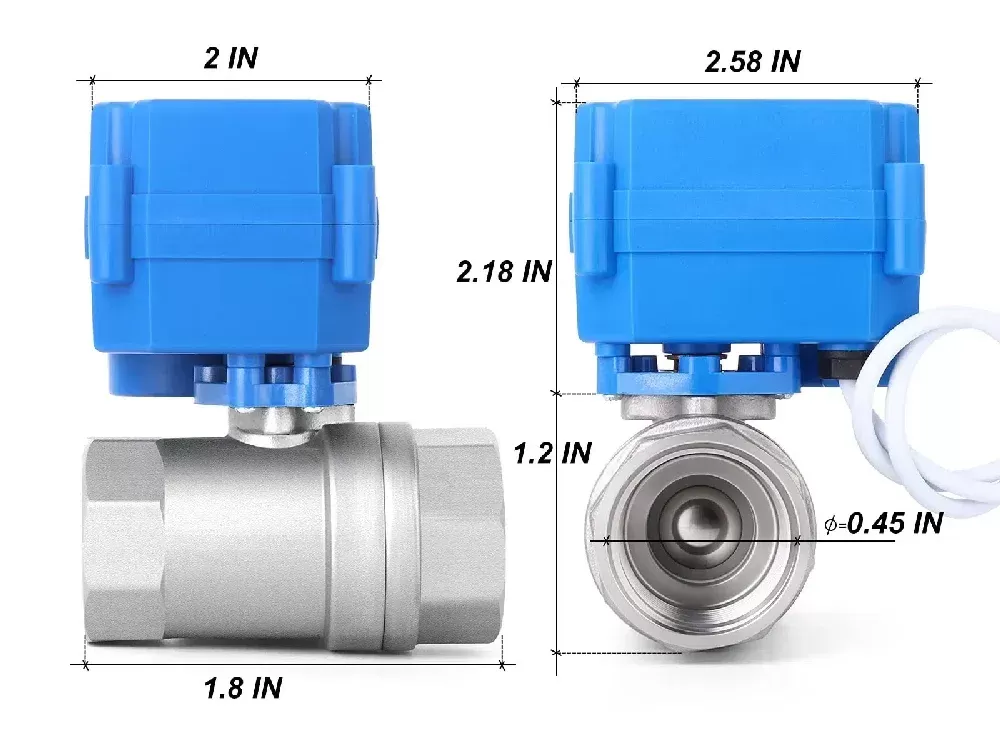Notifications

8 minutes, 19 seconds
-13 Views 0 Comments 0 Likes 0 Reviews

Introduction
Electric ball valves are critical components in industrial and commercial systems that manage the flow of liquids or gases. These China Control Valves integrate mechanical efficiency with electrical automation, offering precise control, rapid response times, and reliable performance even in challenging environments. Unlike manual valves, electric ball valves can be operated remotely, making them ideal for applications where human intervention is impractical or unsafe.
This article will delve into the working principles, key applications, troubleshooting techniques, and maintenance practices for electric ball valves. Additionally, we'll explore the importance of power-failure reset systems in ensuring safety during unexpected power outages.
What Is an Electric Ball Valve?
An electric ball valve is an automated device used to control the flow of liquids or gases. It consists of a spherical plug inside a metal body. The plug features a hollow passage that rotates to open or close the valve, thereby regulating the flow of fluids or gases. An electric actuator, connected to the valve stem, drives this rotation in response to electrical signals.
Fast Operation
Electric ball valves can open or close within seconds, making them suitable for applications requiring high-frequency operation.
Precise Flow Control
These valves can be adjusted to partial openings (e.g., 25%, 50%, 75%) for accurate flow regulation.
Durability
Built to withstand high pressures and temperatures, electric ball valves ensure long-term reliability in demanding environments.
Automation Compatibility
These valves integrate seamlessly with control systems, enabling remote operation.
Safety and Reliability
Electric ball valves reduce human exposure to hazardous environments and enhance process safety.
Electric ball valves are particularly effective for quick shut-offs and moderate flow control. However, for throttling applications that require fine adjustments, other valve types (e.g., gate or globe valves) might be better suited.
How Does an Electric Ball Valve Work?
Working Mechanism Overview
Electric ball valves convert electrical energy into mechanical motion. Upon receiving a control signal, the actuator rotates the ball (typically between 0° and 90°), aligning the bore with the pipeline to permit flow or positioning it perpendicular to block the flow.
Key Components:
Ball: A spherical plug with a through-hole that allows or restricts flow.
Stem: Connects the ball to the actuator, transmitting rotational force.
Electric Actuator: Drives the valve’s movement via a motor.
Positioner: Ensures accurate valve positioning based on control signals.
Step-by-Step Operation:
Signal Reception: A controller sends an electrical signal to the actuator.
Motor Activation: The actuator’s motor engages and rotates the stem.
Ball Movement: The ball turns to the desired position (open, closed, or partially open).
Flow Regulation: The valve either permits, restricts, or stops fluid/gas flow.
Advantages Over Manual Valves:
Speed: Electric actuation is much faster than manual operation.
Safety: Reduces human exposure to hazardous environments.
Integration: Can be linked to PLCs, SCADA systems, and IoT networks for smart automation.
Applications of Electric Ball Valves
Electric ball valves are highly versatile and widely used across multiple industries:
Industrial Processes:
Chemical Processing: Control of corrosive or high-purity fluid transfer.
Oil & Gas: Management of fuel and gas pipelines with high-pressure resistance.
Water Treatment: Regulation of water flow in filtration and distribution systems.
HVAC Systems:
Cooling/Heating Circuits: Modulation of refrigerant or hot water flow.
Energy Management: Automates shut-off to conserve energy in unused zones.
Food & Beverage Industry:
Sanitary Fluid Control: Hygienic fluid handling using stainless steel construction.
Batch Processing: Ensures precise dosing of ingredients.
Power Plants:
Steam Control: Manages high-temperature steam lines.
Coolant Systems: Regulates water flow in cooling towers.
Emergency Shut-Off Systems:
Fire Protection: Automatically shuts off gas or water supply during emergencies.
Leak Prevention: Closes valves in response to pressure drops or power failures.
Troubleshooting and Common Fixes
Despite their reliability, electric ball valves may encounter operational issues. Below are some common problems and their solutions:
Slow or Erratic Valve Movement:
Cause: Low voltage supply.
Solution: Verify voltage at the valve terminals and check power sources.
Excessive Friction or Sticking:
Cause: Lack of lubrication or debris accumulation.
Solution: Clean and lubricate the valve stem according to manufacturer guidelines.
Electrical Interference:
Cause: Nearby electromagnetic sources disrupting signals.
Solution: Relocate the valve or install shielding to prevent interference.
Mechanical Wear:
Cause: Worn-out seals or damaged components.
Solution: Inspect and replace defective parts as needed.
Preventive Maintenance Tips
Regular maintenance ensures the longevity and reliable performance of electric ball valves:
Regular Inspection & Cleaning:
Check for leaks, corrosion, or unusual noises.
Remove debris from the valve body.
Proper Installation Practices:
Follow manufacturer guidelines for alignment and torque settings.
Ensure electrical connections are secure and tight.
Use of Y-Strainers:
Install upstream filters to prevent clogging from particulates and debris.
Scheduled Maintenance:
Lubricate moving parts periodically.
Test valve response to control signals to ensure accurate operation.
Power-Failure Reset Systems in Electric Ball Valves
A critical safety feature in electric ball valves is their ability to close automatically during power failures. This safety mechanism is vital for preventing dangerous leaks or process disruptions during outages.
Spring Reset Mechanism:
A pre-tensioned spring stores energy during normal operation.
In the event of power loss, the spring releases, forcing the valve to close.
Energy Storage Devices:
Advanced valves use capacitors or batteries to store energy and provide power for valve closure.
This ensures a smooth, controlled shut-off, even in the absence of an external power supply.
Why This Matters:
Prevents hazardous leaks in chemical or gas systems.
Complies with safety regulations in critical infrastructure, ensuring reliable operation during emergencies.
Conclusion
Electric ball valves are essential in modern fluid control systems, offering automation, precision, and enhanced safety. Understanding their operation, applications, and maintenance practices ensures optimal performance and long-term durability. By implementing preventive maintenance and utilizing power-failure reset systems, industries can improve efficiency while minimizing operational risks.
Whether used in water treatment, oil refineries, or HVAC systems, electric ball valves continue to advance flow control technology with their reliability and versatility. Investing in high-quality valves and regular maintenance will provide long-term operational benefits for any industrial application.Know more about Google SEO Directory

